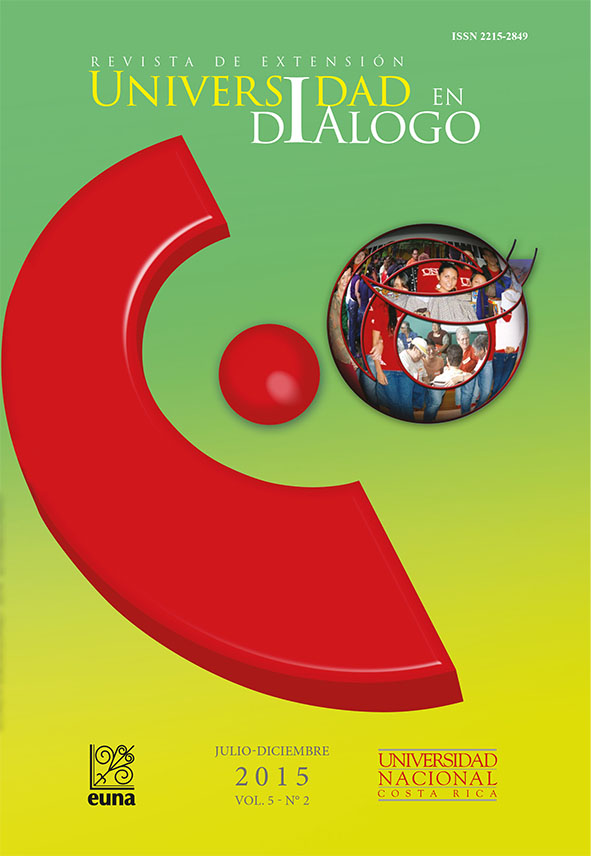Phytoplankton Production for Research and Teaching in Larviculture Shrimp, Shellfish and Fish, 2008-2013
Keywords:
Marine Phytoplankton, production, species isolationAbstract
From 2008 to 2013 production of marine phytoplankton was a miscellaneous activity that supporter teaching, investigation and extension. For this, improvements were made annually in the massive production, maintenance of stock and intermediates; considering the factors of tension detected last year, five fundamental products are reported: 1- acquisition of 11 certified species, 2- improvements in massive production protocols, 3- isolation of two endogenous species to the Gulf of Nicoya, 4- acclimation and scaling to 2 Tons of one species endogenous to the Gulf of Nicoya classifies as spl. And 5- a 60% increment in the production of massive cultures. During this period, 10 species were used as didactic material in 7 courses of levels III and IV of the Marine Biology career. The results accomplished indicate that this activity has contributed to the development of teaching, investigation and extension that promotes the School of Biological Sciences. It is important to continue the task of acquiring endemic, acclimated species that are identified and validated as a source of live food, through the biochemical characterization of the nutritional profile in the isolated species.References
Chacón C, Andrade C., Cárdenas C., Araujo I., y Morales E. (2004). Uso de Chlorella sp. y Scenedesmus sp en la remoción de nitrógeno y fósforo y DQO de aguas residuales urbanas de Maracaibo, Venezuela. Boletín del Centro de Investigaciones Biológicas. Volumen 39. Nº. 2, p.94-108. Universidad del Zulia, Maracaibo, Venezuela.
Collos, Y. (2011). A linear model of external interactions during uptake of different forms of inorganic nitrogen by microalga.Journal of Plankton Research, 35(3), 461-472.
Ching-Piao, L. y Liang-Ping,L. (2001).Ultrastructural study and lipid formation of Isochrysissp. CCMP1324.Botanical Bulletin of Academia Sinica, 42, 207-214.
Fujiki, T. y Taguchi, S.(2002). Variability in chlorophyll a specific absorptioncoefficient in marine phytoplankton as a function of cell size and irradiance.Journal of Plankton Research, 24(9), 859-874.
Ganguly,D. Robin, R.S., Vardhan K.V., Muduli, P.R, Abhilash, K.R, Patra S., Subramanian, B.R. (2013). Variable response of two tropical phytoplankton species at different salinity andnutrient condition. Journal of Experimental Marine Biology and Ecology 440, 244-249. Recuperado de www.elsevier.com/locate/jembe
Lemus, N., Urbano, T., Arredondo-Vega,B., Guevara,M., Vásquez, A., Carreón-Palau,L., Vallejo,N.(2006).Crecimiento y perfil bioquímico de Chaetocerosmuelleri cultivada en sistemas discontinuos y semicontinuos. Ciencias Marinas, 32(3), 597-603.
Li, S., Xu J., Chen J., Chen J., Zhou C., Yan X. (2014). The major lipid changes of some important diet microalgae during the entire growth phase. Aquaculture, (428-429), 104-110. Recuperado de www.elsevier .com/locate/aqua-online.
Loureiro, S., Jauzein, C.Garce, E. Collos, Y. Camp J.y Vaque, D. (2009). The significance of organic nutrients in the nutrition of Pseudo-nitzschiadelicatissima (Bacillariophyceae).Journal of Plankton Research 31 (4), 399-410.
Morris H., Ramírez, A., Martín, M., Borges, L. y Olivares, G. (2004). Cinética de crecimiento y producción de polisacáridos por la microalga Porphyridiumcruentum (Rhodophyta, Porphyridiaceae) en condiciones de radiación solar difusa. Tecnología Química, 24 (1), 73-78.
Muller-Feuga, A. (2004). Microalgae for aquaculture. EnA. Richmond (Ed). Handbook of microalgal culture: biotechnology and applied phycology. Oxford:BlackwellScience, pp. 352- 364.
Nieves, M., López,D., Medina,M., Piña, P., Leal,S., López-Elías,J. (2009). Producción y calidad de ChaetocerosMuelleri a diferentes concentraciones de nutrientes y densidades de inóculos. Rev. Invest. Mar., 30(2), 123-133.
Pettersen, A., Turchini,M. G., Jahangard,S., Ingram,B. A., Sherman,C. D. (2010).Effects of different dietary microalgae on survival, growth, settlement and fatty acidcomposition of blue mussel (Mytilusgalloprovincialis) larvae.Aquaculture, 309, 115–124.Recuperado de: www.elsevier.com/ locate/aqua-online
Priyadarshani, I., Sahu,D.,Rath,B.(2012). Algae in Aquaculture. International Journal of Health Sciences & Research 108, 2. Recuperado http://www.ijhsr.org/current_PDF2/14.pdf
Provasoli-Guillard National Center for Marine Algae and Microbiota.Recuperado de http://www.bigelow.org/catt/bigelow-center-for-blue-biotechnology/
Richmont, A. (2004). Handbook of Microalgal Culture: Biotecnology and Applied Phycology. Great Britain. Blacwell Science Asia. 565pp.
Ruiz-Guzmán, J. A., Jiménez, C. A., Gomes, C., Prieto, M. J. (2012). Cultivo experimental de Cyclopinasp con diferentes especies de microalgas. Revista Colombiana Ciencias Pecurias, 25, 97-105.
Vásquez-Suárez, A., Guevara, M., González, M., Lemus, N., Arredondo-Vega, B. (2010). Crecimiento y composición bioquímica de Skeletonemacostatum (greville, 1866) cleve, 1878 (heterokontophyta: bacillariophyceae) en función de la irradiancia y del medio de cultivo. Saber Universidad de Oriente, Venezuela, 22(2), 149-159.
Downloads
Published
How to Cite
Issue
Section
License

La Revista y cada uno de los artículos que se publican están licenciados por Creative Commons Atribución No comercial Sin derivadas 4.0 Internacional.



